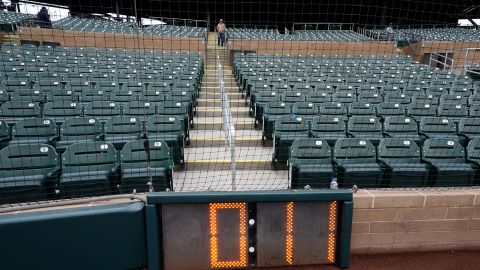
Editor’s Note: Frederic J. Frommer, a writer and sports historian, is the author of several books, including “You Gotta Have Heart,” a history of Washington baseball. Follow him on Twitter at @ffrommer. The views expressed in this commentary are his own. View more opinion articles on CNN.
CNN
—
In recent years, there has been a lot of standing around in baseball games, with pitchers taking forever to throw the ball and hitters frequently stepping out of the batter’s box. This year, Major League Baseball will try to speed things along with a clock that caps the amount of time between pitches.
It might sound like a radical idea, but the same concept saved the National Basketball Association nearly 70 years ago. In both cases, the clock was added to accelerate a plodding game.
Baseball games have been getting longer in recent years, dragging on for an average of more than three hours, compared to two-and-a-half hours in the 1970s. It’s even worse in the playoffs, with games often exceeding four hours.
Baseball hopes to reverse that trend this year, with a 15-second clock for each pitch when the bases are empty, and 20 seconds with runners on base. In addition, batters will be limited to one timeout per at-bat, and there will also be a 30-second timer between hitters. (The sport is making other changes, including banning the defensive infield shift to generate more offense, and making bases slightly larger to increase safety and possibly jumpstart stolen base attempts. All the new rules will be in effect for spring training games, which begin February 24 ahead of the 2023 season Opening Day on March 30.)
For more than 150 years, the lack of a clock on the field has distinguished baseball from other major US team sports, and some baseball purists are sure to object to adding one. “There’s no clock in baseball. And there’s no clock in baseball for a reason,” now-New York Mets star pitcher Max Scherzer said in 2019.

But it’s the growth of interminable games that’s really the break from tradition.
Last year’s World Series between the Houston Astros and Philadelphia Phillies, for example, included a four-and-a-half hours game (which went into 10 innings) and a nine-inning game that lasted nearly four hours. In 2020, the New York Yankees and Cleveland Indians slogged through a nine-inning game that lasted a whopping four hours and 50 minutes — longer than some doubleheaders used to take back in the day.
The implementation of the “pitch clock” will lead to more action and less standing around — in other words, more baseball. What could be more traditional than that? Baseball will never be a fast-paced game, but there’s no reason it has to be a slow-paced one. A clock will suck a lot of dead time from the sport and quicken the game.
Baseball has already implemented the clock in the minor leagues, and last season, the average length of games dropped by 25 minutes, from 3:03 to 2:38. So it’s proven to make the game faster.
As the length of MLB games has increased, attendance has gone in the opposite direction, with smaller crowds last season than pre-pandemic levels. MLB Commissioner Rob Manfred hopes a clock will help reverse that trend.
MLB faced a similar challenge a half-century ago when dominant pitching led to an era of low-scoring games that eroded attendance. In 1969, the sport responded by lowering the pitcher’s mound, which literally put pitchers and hitters on a more level playing field and led to increased hitting and more scoring.
Four years later, the American League adopted the designated hitter (or DH, a non-fielding player who’s in the batting lineup, typically replacing the pitcher) to inject yet more offense. Last season, MLB made the DH universal across both leagues.
Now baseball is putting pitchers on a stopwatch for the same reason the NBA adopted the 24-second shot clock in 1954: to make games more entertaining for fans.
Basketball in the early ’50s was often a bore, with teams sitting on leads by passing the ball back-and-forth without attempting to score, and it wasn’t unusual for a team to take five minutes before taking a shot. The nadir of this strategy came in a 1950 game between the Fort Wayne Pistons and the Minneapolis Lakers, who had won the NBA championship in the previous season, the inaugural year of the league.

Pistons coach Murray Mendenhall, realizing he was facing a superior team, ordered his players to stall. At the end of the first quarter, the Pistons led 8-7, and the action was so slow that fans, opponents and even the referees urged the team to attempt more shots. But the Pistons stuck to their guns, and outscored the Lakers 3-1 in the fourth quarter on their way to a 19-18 victory — the lowest scoring game in NBA history.
“Play like that will kill professional basketball,” groused Lakers coach Johnny Kundla. Seven decades later, Sports Illustrated baseball writer and Fox broadcaster Tom Verducci made the same prediction about baseball.
“Dead time in a game since Manfred became commissioner in 2015 has increased 17%,” Verducci wrote last year. “It’s not all on him. Players keep saying they don’t want to be told to hurry it up, cluelessly slow-playing their own way into oblivion.” The MLB Players Association opposed rules changes to add a clock (and ban defensive shifts).
Back in the early ’50s, the owner of the NBA’s Syracuse Nationals, an Italian immigrant and bowling alley proprietor named Danny Biasone, knew the league had to make basketball more exciting for fans.
”I’m not an expert on the game,” Biasone told The New York Times in 1984. ”I never claimed to be. But I knew fans weren’t paying to see the ball being dribbled around all night. So I went to those fellas in the league and said I’m having a tough time selling something here. There’s one thing basketball needs, I said. It needs a time. I don’t care what the time is. Put in a time!”
NBA owners knew they had to do something — nine of the 17 franchises had folded in the previous four years, and the league was becoming irrelevant at a time when baseball reigned as America’s most popular sport. That’s why, in April 1954, the NBA adopted the clock in an attempt to end stalling.
The impact was immediate: average team scoring per game increased from 79 points to 93. That figure rose to 106 by 1958, and not coincidentally, attendance soared by 40%.
“The adoption of the clock was the most important event in the NBA, and Danny Biasone is the most important man in the NBA,” said Maurice Podoloff, who was league president at the time. Today, basketball is a thrilling game, with superstars showing off their talent in constant action.
As for baseball, New York Mets announcer Keith Hernandez, a former star player, said the game has gotten too slow even for him. “I honestly feel that when I’m retired, when I stop doing what I’m doing now in the booth, I won’t watch baseball that much anymore,” he said in January. “It’s three-hour games now, three-and-a-half, when I played it was two-and-a-half. I still love the game, but they’re lengthy.”
Baseball has long struggled to attract young fans, in part because of the slow pace of play. When the sport starts losing 69-year-old baseball lifers like Hernandez, you know it has a problem.
People don’t come to games to watch guys stand around and do nothing — whether it’s on a basketball court or a baseball diamond. A clock won’t have the same dramatic effect on baseball that it had on the NBA. But for Americans with limitless entertainment options and limited time, it will help attract fans with more exciting (and faster) baseball games than we’ve seen in years.


